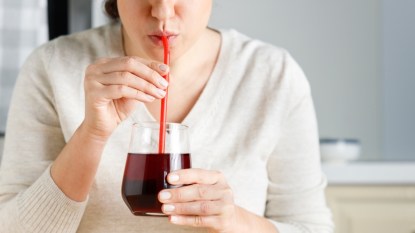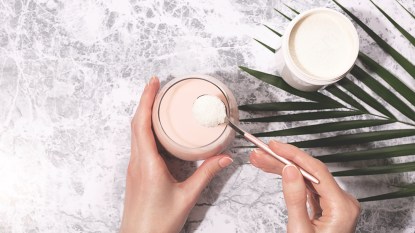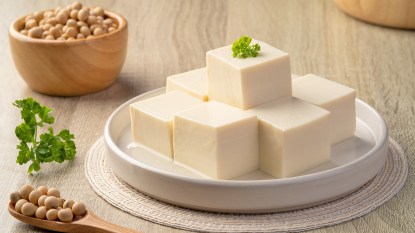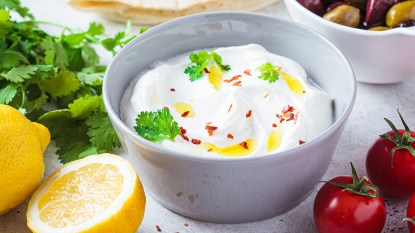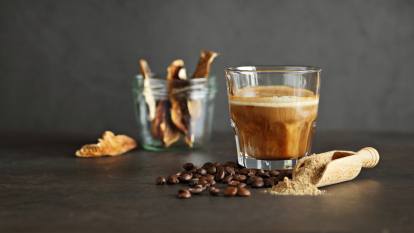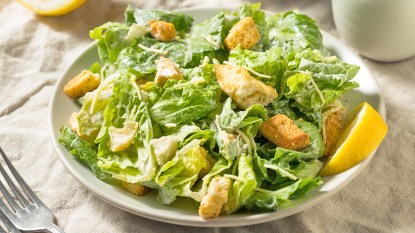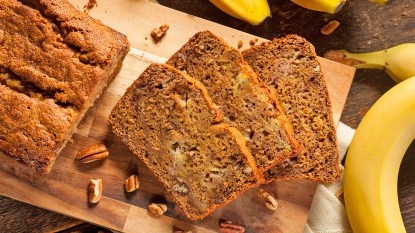Does Chocolate Have Caffeine? Yes — And Higher-End Dark Chocolates Have The Most
Candy doesn't have to list caffeine content on the label, so we asked nutritionists to weigh in
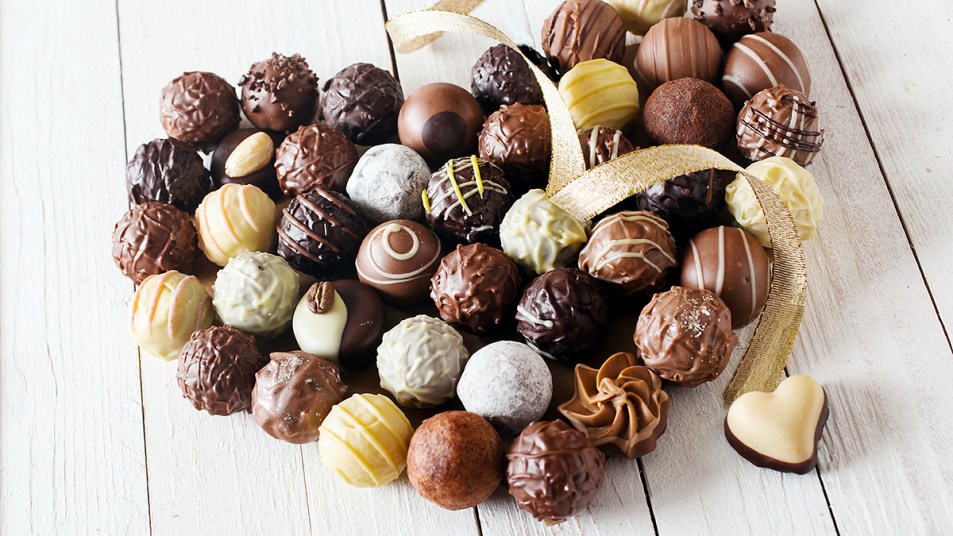
Indulging in chocolate is a surefire way to put a little pep in your step — and not just because it’s so delicious. Chocolate is packed with healthy compounds that have been shown to boost mood, reduce stress and rev energy. But does it have caffeine? We talked to experts to get to the bottom of this question — and others. Read on for their answers.
First, a bit more on those benefits above. Chocolate in general contains natural compounds called polyphenols that studies have found can turn around a bad mood, and dark chocolate is particularly high in these compounds. But chocolate’s powers reach beyond elevating a blue mood. In fact, a study published in the International Journal of Health Sciences found that enjoying just 40 grams of dark or milk chocolate (that’s about the size of a traditional Hershey bar) is a tasty way for women to reduce stress on the spot.
Does chocolate contain caffeine?
While there are more different kinds of chocolate than we can list here, the main ‘eating chocolate’ falls into three categories: Dark, milk and white. Dark and milk chocolate both have caffeine, with dark chocolate having roughly twice as much caffeine as milk chocolate.
“Dark chocolate and raw cacao powder, often used to make cakes and baked goods, are going to have more caffeine than, say, a Hershey’s milk chocolate bar,” says Melanie Murphy Richter, MS, RD, a registered dietitian nutritionist and instructor of Nutrition Physiology at the University of California Irvine, “and as a result can spark a greater heightened alertness or improved focus.” (On the flip side, click through to learn how curbing caffeine can ease restless leg syndrome.)
The caffeine content of different kinds of chocolate
Before we can figure out just how much caffeine you’re getting in a chocolate bar, let’s do a bit of math: A standard dark-chocolate Hershey bar is 1.55 oz., or 44 grams. According to the United States Department of Agriculture, dark chocolate, the least processed variety, contains 43 mg of caffeine per 100 grams, and milk chocolate contains 20 mg of caffeine per 100 grams. So that Hershey-sized bar is delivering 10 to 20 mg of caffeine — about 20% of the caffeine in a cup of coffee (though various factors can make that number higher or lower, as you’ll see below). If the candy bar were milk chocolate, it would contain less than 10 mg of caffeine. White chocolate, which is made from cocoa butter, milk solids and sugar, does not contain any caffeine because it does not contain any cocoa solids.
Do chocolate and cocoa have equal amounts of caffeine?
At their core, cocoa powder and chocolate are very similar. Both begin as cocoa beans that are dried, roasted, then ground into a powder that’s called cocoa solids. Chocolate candies, chips, bars and other treats are produced by mixing that powder with ingredients like milk solids, sugar and sometimes flavors like raspberry or orange.
Products listed as 100% cocoa powder are not mixed — or sweetened — with other ingredients. That lack of additives or other processing greatly increases the amount of caffeine in cocoa powder. Indeed, Kathryn Piper RDN, LD, NBC-HWC, explains that the cocoa powder in your pantry could have as much as four (or more!) times the amount of caffeine as chocolate, depending on the type. “100 grams of cocoa powder [that’s 3.5 oz., or 7 tablespoons] has 230 milligrams (mg) of caffeine, while the same amount of dark chocolate has 43 mg,” says Piper. For reference, a cup of coffee has 80 to 100 mg of caffeine.
That said, you may be wondering about the caffeine content of homemade hot chocolate that’s made using cocoa powder: A typical hot cocoa recipe calls for 2 tablespoons per serving, which would deliver 66 mg of caffeine — almost as much as a cup of coffee. When it comes to mocha coffee, you’d be adding one tablespoon of cocoa to a cup of coffee, so you’d be getting more than 100 mg of caffeine.
Why does dark chocolate have the most caffeine?
Since the key to caffeine content is cocoa solids, the amount of cocoa in a piece of chocolate corresponds to its caffeine levels. “Dark chocolate has the highest content of cocoa solids. Therefore, it has the highest caffeine content compared to milk and white chocolate.”
Dark chocolate’s notorious bitter flavor, which comes from it having less sugar than milk chocolate, also plays a role. “Having less sugar means there will be more room for cocoa solids in dark chocolate, resulting in higher levels of caffeine,” adds Lori Walker, a registered dietitian and creative recipe developer. Piper adds that dark chocolate contains compounds that trigger the brain to release feel-good hormones called endorphins, to boost your mood almost instantly, which she says can also elevate your energy levels. (Click through to see how eating dark chocolate instead of milk is a food swap that blocks diabetes.)
Does price affect caffeine content?
Grabbing a name-brand candy bar could possibly increase the amount of caffeine in a velvety chocolate treat, says Walker. That’s because the amount of cocoa solids used in a chocolate bar can have a direct impact on a product’s caffeine content. “Generally, higher-quality chocolates tend to use more cocoa solids, which means they’re more likely to contain more caffeine than cheaper alternatives.”
Higher-end chocolates may also use better-quality cocoa beans that can contain more caffeine, while cheaper chocolates may use inferior cocoa beans with less caffeine.
Do candy bar labels list caffeine?
Caffeine can be hard to spot in chocolate treats because the Food and Drug Administration (FDA) only requires that manufacturers list added caffeine on food and drink ingredient labels. Since cocoa beans naturally contain caffeine, manufacturers of chocolate products are not required to list the caffeine content on labels. “Spotting caffeine on a food label indicates caffeine has been added to the product,” says Piper.
Can eating chocolate before bed keep me up at night?
Eating chocolate before bed can disrupt your sleep, says Walker. “Because of its caffeine content, goodies made with cocoa powder and dark chocolate are the biggest offenders, but milk chocolate can also disrupt sleep.” And it’s not just because of the caffeine! The sugar in chocolate can also make it tough to fall — or stay — asleep, which is why Walker suggests passing on chocolate (or any sugary dessert) within 2 to 3 hours of turning in for the night.
Love your post-dinner chocolate? Choose white. Because it lacks caffeine, Rebecca Novak, a New-York based registered dietitian and chef, suggests enjoying one or two small bites of white chocolate to soothe your sweet tooth without consuming too much sleep-busting sugar. (Click through for another delicious bedtime snack that will help you sleep better!)
For more sweet chocolate news, check out these posts:
Eating Chocolate Really Can Cure Stress, say the Experts, And Other Self-Care Tricks To Boost Joy
Eating a Bar of Milk Chocolate at This Time Burns Fat and Lowers Blood Sugar, Study Suggests





